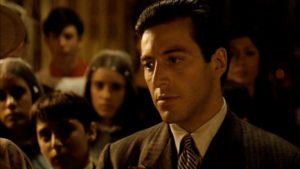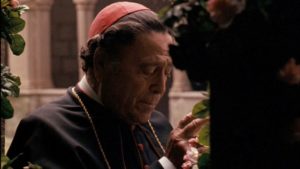The Godfather: Part III (1990). Written by Mario Puzo and Francis Ford Coppola. Directed by Francis Ford Coppola. Starring Al Pacino, Diane Keaton, Andy Garcia, and Sofia Coppola. 162 mins. Rated R.
CONFESSION
The first and last and only time we ever see Michael Corleone (Al Pacino) in a church is at the end of the first in the trilogy, The Godfather (1972)—and then the chief purpose of his visit lies in cloaking the depth of his evil—namely, to supply an alibi while his henchmen assassinate the heads of the other crime families. Ostensibly, Michael is there within the sacrament to embrace publicly his role as godfather to his infant nephew (alas, can one godfather a crime mob and a child?). The sacrament demands that the godfather of the child publicly renounce Satan and all his ways. Here the chiaroscuro lighting shows the whole story.
STILL

Decades later in The Godfather: Part III (1990) he again goes to church, so to speak, this time though it is a meeting in a garden with one Cardinal Lamberto (Raf Vallone), a fictional character who will become John Paul I, an actual pope who in 1978 died under mysterious circumstances just a month after becoming pope and, importantly for conspiracy theorists, initiating an investigation into the finances of the Vatican Bank.
In this third and last film the Godfather saga Michael Corleone’s business career has flourished enormously—though some enterprises are hardly legit—and though he is mega-rich and powerful he is beset by rivals every bit as ruthless as he is. Under siege, including still another attempt on his life, Michael Corleone, gravely ill and haggard, goes to the future pope for counsel on how to deal with corrupt rivals within the arcane finances of the Vatican bank. Except, surprise, in a quiet courtyard garden, with a future pope showing the way, Michael at last confronts his own biggest enemy, an entity that has nothing and everything to do with his business empire—himself. The amply perceptive, and merciful, Lamberto–who is, after all, first and last, a priest in the Christian church–addresses Michael’s deepest problem by gently but urgently pushing Michael to confess his many sins, some of which are monstrous beyond reckoning.

Michael knows he’s sordid and lost and avers that his sins are so many and great and that he has not confessed in decades and doing so now would take too long. Moreover, he does really believe that he is not the usual sinner and that he is beyond redemption. Still, Lamberto coaxes, and at last Michael lets open the floodgates of crime, guilt, and grief, most notably the fratricide decades before of brother Fredo (John Cazale) in The Godfather: Part II (1974).

It is a scene of staggering power as Michael weeps and weeps, shaken to his core by the specter of his own deeds and his own malign inmost self. After all, this is the same fellow who once proclaimed that he wanted nothing to do with the family business (crime) and that he was fundamentally different and separate from his felonious clan. Now, though, Michael reckons with his own grotesque, murderous self, and he finally, improbably, urged on by the depthless kindness of a priest, opens to the wildly improbable notion that he too can perhaps find for his dark, unquiet soul a measure of redemption. And for this, happily, Pacino does the very best acting of his fabled career. Michael knows he needs redemption, and he even in the film moves toward the destination Lamberto advises, and lo, he almost arrives till, once again, circumstances come to get him. The world he made will not let him go, as he screams earlier in the film. The sequence is remarkable and readily viewable in a sermon, for such is the look of actual confession, and for ourselves and for Michael we all should weep for ultimately all dispute and transgress the love of God in countless ways small and large.
Sequence: 1:40:59-1:44:34
Here, at once poignant and searing, confession happens, and truth be told, Michael is everyman, no more grievous than any mortal soul in failing to see the fundamental bentness of self that all humankind shares. And this is what confession looks like after, at last, seeing fully one’s own inner disfigurement, enmity, and woe: every man and every woman, we are him and he is us, grievous and lost. For him, and for us, there is hope, though it may take awhile to get there, for later in the film Michael does indeed turn, seemingly finally having gotten the hope of redemption, and that too shakes the soul, his and ours (See Redemption).
written by Roy Anker
Sign Up for Our Newsletter!
Insights on preaching and sermon ideas, straight to your inbox. Delivered Weekly!
Categorized into Confession
The Godfather: Part III (1990) – 1